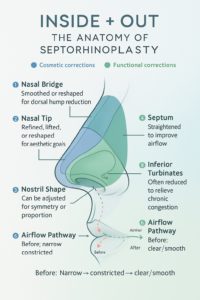When it comes to nose surgery, it’s easy to get overwhelmed by the terminology. You may have heard terms like rhinoplasty or septorhinoplasty tossed around—but how do you know which one you actually need? While they sound similar, they’re quite different in purpose and scope. One focuses strictly on appearance, while the other improves both form and function.
At the South Florida Center for Cosmetic Surgery, we believe in educating our patients, so you feel confident every step of the way. If you’re considering a nose job—whether for aesthetic reasons, breathing issues, or both—this blog will help clarify your options and guide you toward the right procedure for your goals.

What Is Rhinoplasty?
Rhinoplasty, often referred to as a “nose job,” is a cosmetic procedure designed to reshape or refine the external appearance of the nose. This surgery can address concerns like:
- A dorsal hump (bump on the bridge of the nose)
- A drooping or bulbous nasal tip
- Wide or flared nostrils
- Nose size or projection imbalances
- Asymmetry after trauma or previous procedures
Rhinoplasty may be performed using an open or closed technique, depending on the complexity of the case and your desired results. Most importantly, rhinoplasty is primarily about how your nose looks—not how it functions internally.
What Is Septorhinoplasty?
Septorhinoplasty is a dual-purpose surgical procedure that combines both septoplasty (to correct a deviated septum and improve nasal airflow) and rhinoplasty (to reshape the external appearance of the nose). By merging these two surgeries into one comprehensive treatment, septorhinoplasty addresses both functional and cosmetic concerns in a single, streamlined approach.
The septoplasty portion of the surgery focuses on the internal structure of the nose—specifically the nasal septum, which is the wall of cartilage and bone that separates the two nostrils. When the septum is crooked or off-center (a condition known as a deviated septum), it can block airflow and lead to breathing difficulties, chronic nasal congestion, sinus infections, nosebleeds, snoring, or disrupted sleep.
Meanwhile, the rhinoplasty component is dedicated to the external shape and structure of the nose. This can include refining the nasal bridge, reshaping the tip, adjusting nostril width, or correcting asymmetries to create a more balanced and harmonious facial profile.
Patients who undergo septorhinoplasty often suffer from:
- Difficulty breathing through one or both nostrils
- Frequent nasal congestion
- Snoring or sleep-disordered breathing
- Cosmetic concerns, such as a dorsal hump, drooping tip, or wide nasal bridge
By combining both techniques into a single procedure, patients benefit from a more efficient recovery, enhanced overall results, and the convenience of correcting both form and function at once. This approach is ideal for those who want to breathe better while also feeling more confident.
Key Differences Between Rhinoplasty and Septorhinoplasty
Feature | Rhinoplasty | Septorhinoplasty |
| Focus | Cosmetic only | Cosmetic + Functional |
| Addresses breathing issues? | No | Yes |
| Involves internal nasal structure? | No | Yes (nasal septum) |
Typical candidates | Patients with aesthetic goals only | Patients with functional + aesthetic concerns |
Can You Get a Septoplasty Without a Rhinoplasty?
Yes—septoplasty can absolutely be performed on its own, without any changes to the external shape of the nose. This option is ideal for patients who are happy with the appearance of their nose but are struggling with functional issues like:
- Chronic nasal congestion
- Frequent sinus infections
- Difficulty breathing through one or both nostrils
- Snoring or sleep disruptions caused by airflow restriction
Septoplasty is a functional procedure designed to straighten a deviated septum, which is the wall of cartilage and bone that separates the nasal passages. When the septum is misaligned, it can block airflow and lead to persistent breathing problems—especially on one side of the nose. During the procedure, the surgeon carefully repositions or removes portions of the septal tissue to open up the airways and restore proper function.
Because no external nasal structures are altered, there are typically no visible changes to your appearance. This makes standalone septoplasty a great option for patients focused purely on improving breathing—not aesthetics.
At the South Florida Center for Cosmetic Surgery, our experienced team will walk you through both standalone and combined options to ensure your treatment aligns with your goals, anatomy, and lifestyle.
When Rhinoplasty May Be Right for You
Rhinoplasty may be the best fit if:
- You’re happy with how you breathe but want to improve the shape of your nose
- You want a more balanced facial profile or symmetry
- You have no history of trauma or nasal blockages
- Your goals are purely cosmetic in nature
Many patients pursue rhinoplasty to feel more confident in photos, enhance their side profile, or simply feel more aligned with their facial features. It’s one of the most popular facial surgeries—and with the right surgeon, results can be natural, subtle, and stunning.
When You May Need Septorhinoplasty
Septorhinoplasty is typically recommended if:
- You’ve been diagnosed with a deviated septum
- You struggle with chronic nasal obstruction or snoring
- You’ve had trauma to the nose that affected function
- You want to improve both appearance and airflow
- You’re revising a previous rhinoplasty that affected breathing
Many patients don’t realize their nasal breathing problems stem from a deviated septum until their consultation. Our surgeons take time to evaluate the internal anatomy of your nose to determine if septorhinoplasty is a more comprehensive and beneficial approach.
What If I’ve Already Had a Rhinoplasty?
If you’ve had a previous nose job but are still struggling with breathing issues—or feel unsatisfied with your results—you may be a candidate for revision septorhinoplasty. This secondary procedure can correct internal structural problems, restore balance, and improve airflow while refining the appearance of the nose.
Revision procedures are more complex and require a skilled surgeon with expertise in both cosmetic and functional nasal surgery. At South Florida Center for Cosmetic Surgery, we specialize in revision work and personalized solutions for complex cases.
Recovery: Is One Procedure More Difficult?
While both procedures have similar timelines, septorhinoplasty often involves a bit more internal healing due to the work on the septum and nasal passages.
Rhinoplasty Recovery:
- Mild to moderate swelling and bruising
- Congestion for a few days post-op
- Most patients return to work within 7–10 days
Septorhinoplasty Recovery:
- Internal splints may be placed for support
- More noticeable congestion and pressure for 1–2 weeks
- Healing of both internal and external structures takes place simultaneously
- Final results visible around 6–12 months
Regardless of the procedure, our care team ensures you’re supported with pain management, recovery tips, and follow-up visits throughout your healing journey.
Choosing the Right Surgeon Matters
Nose surgery requires a delicate balance of structure, proportion, and function. That’s why it’s essential to choose a provider with experience in both cosmetic and functional nasal surgery.
At South Florida Center for Cosmetic Surgery, our facial plastic surgeons have performed hundreds of rhinoplasties and septorhinoplasties—each one tailored to the patient’s unique facial features and functional needs. Whether you’re refining the nasal tip, restoring balance after trauma, or seeking relief from chronic breathing issues, you’ll receive a plan designed around you.
Final Thoughts: Septorhino vs. Rhino—Which Is Right for You?
The best way to determine whether you need rhinoplasty or septorhinoplasty is through a personalized consultation. We’ll assess your goals, examine both the internal and external structure of your nose, and help you understand the full scope of what’s possible.
Here’s a quick recap:
- Choose rhinoplasty if you want to improve the look of your nose
- Choose septorhinoplasty if you want to improve both look and function
- Consider revision septorhino if you’ve had a previous procedure but still have concerns
Your nose is one of the most central features of your face—and how it looks and functions can deeply affect your quality of life. Whether you’re coming in for your first consultation or exploring options after a previous surgery, our team is here to support your journey with expertise, compassion, and beautiful results.




